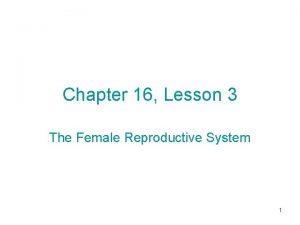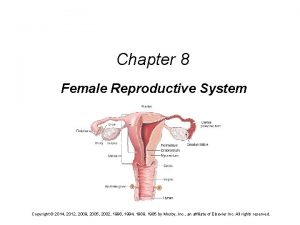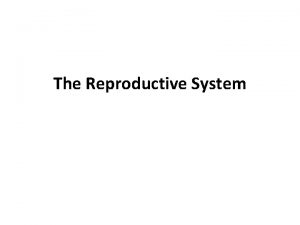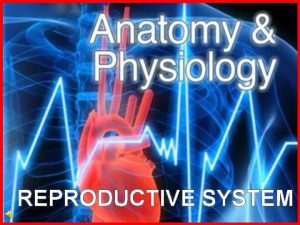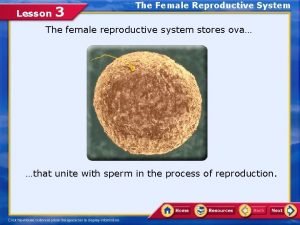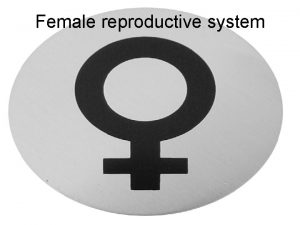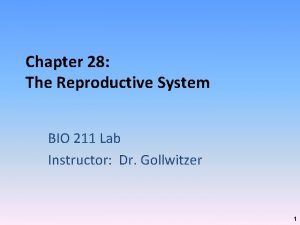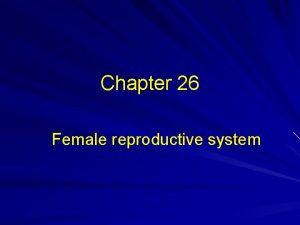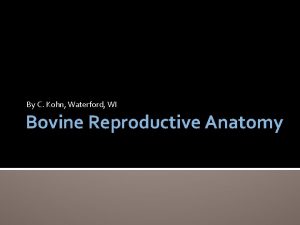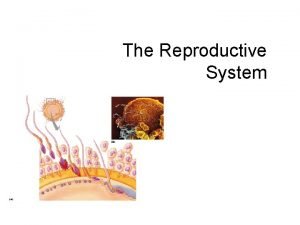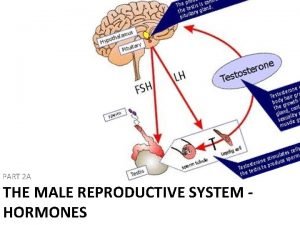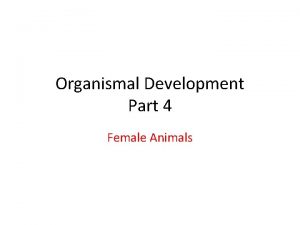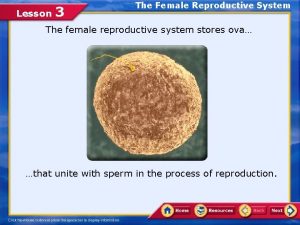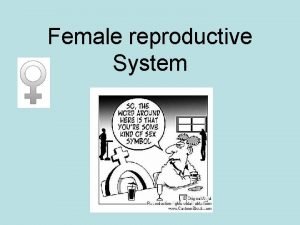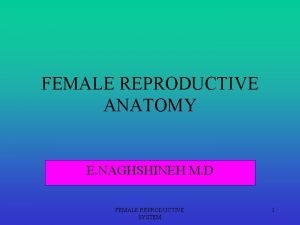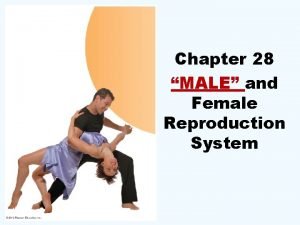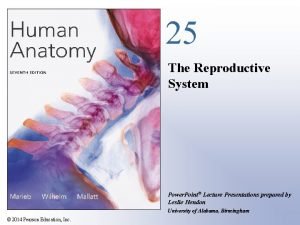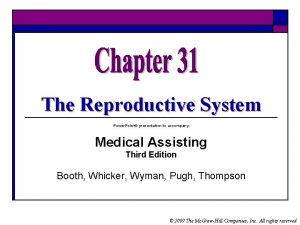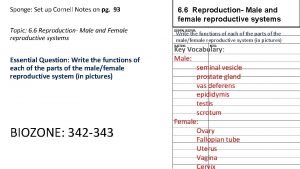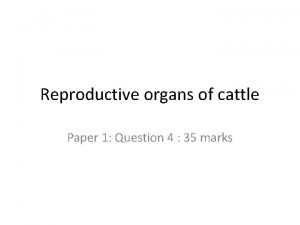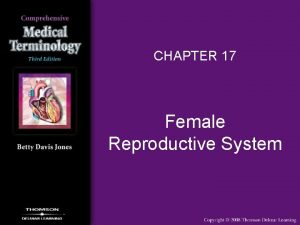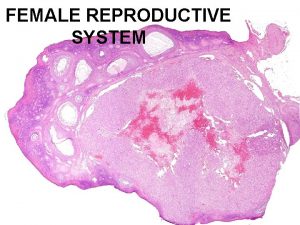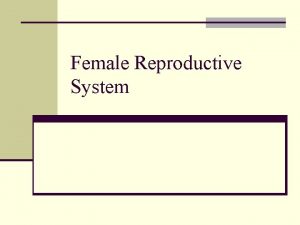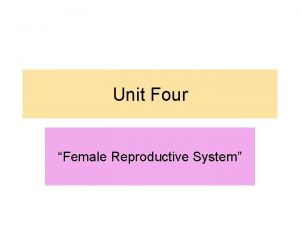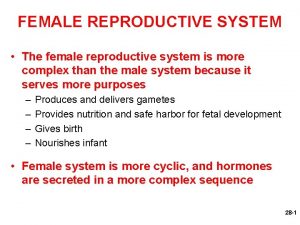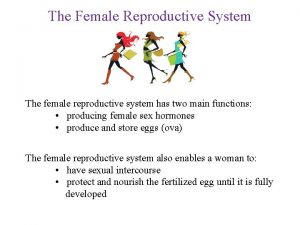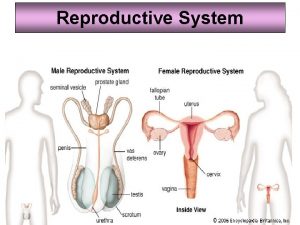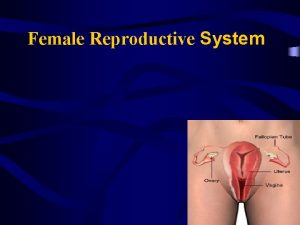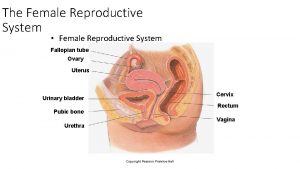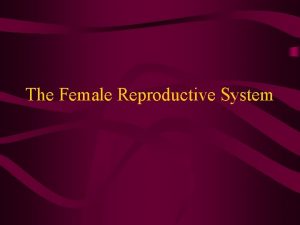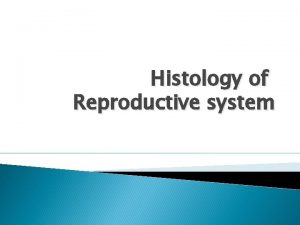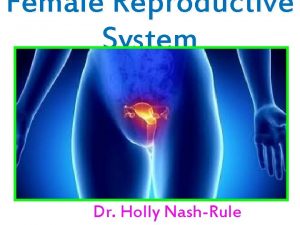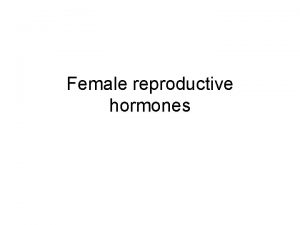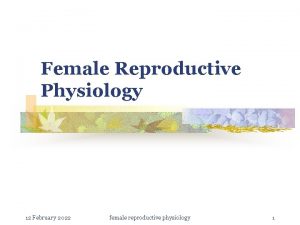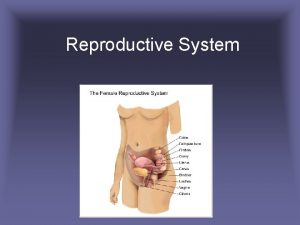Chapter 8 Female Reproductive System Female Reproductive System

































- Slides: 33

Chapter 8 Female Reproductive System

Female Reproductive System • Sexual reproduction is the union of the nuclei of the female sex cell (ovum) and the male sex cell (sperm) that results in the creation of a new individual • Sex cell is called a gamete • Gametes are produced in special organs call gonads. (female=ovaries; male= testes) • An ovum leaves the ovary and travles down the fallopian tubes. If coitus (sexual intercourse) occurs and sperm cells are present in the fallopian tubes, fertilization may take place. The embryo then will begin a 40 wk gestation/ pregnancy in the uterus

Ovaries • Ovary= (oophor/o or ovari/o) • Ovary=Female gonads or sex glands • Located in the pelvic cavity and attached to the uterus by ligaments • Graafian Follicles: small sacs in the ovaries containing immature ovum. When the ovum matures, the follicle releases the ovum and ovulation occurs • Bilateral Oophorectomy: (oophor/o=ovary; -ectomy= removal); female castration; removal of both ovaries • Bilateral Salping-oophorectomy: (salping/o=fallopian tubes; removal of both the fallopian tubes and ovaries • Pelvic exenteration- removal of internal and external organs in the region of the hip

Fallopian Tubes • Adnexa Uteri- (adnexa=accessory); fallopian tubes and ovaries are considered accessory organs • Fallopian Tubes; (salping/o) • Two tubes attached to the upper part of the uterus • Lateral ends located above the ovaries but no direct connection • Fimbriae: finger-like projections help move the ovum from the ovary to the fallopian tube • Passageway for ovum as it moves from the ovary to the uterus • Fertilization typically takes place in the fallopian tubes • Ectopic pregnancy: (ec-=outside; top=place/position; -ic= pertaining to); pregnancy outside the uterus often occurring in the fallopian tubes • Pyosalpinx- Py/o= pus; pus (infection) in fallopian tubes

Organs of the female reprodutive system (anterior view). Fig. 8 -3. Copyright © 2001 by W. B. Saunders Company. All rights reserved. Back MENU Forward

Uterus • Uterus: (metr/o; metr/i; uter/o) • Hollow, muscular , pear-shaped organ • Located behind urinary bladder but in front of the rectum in pelvic cavity • Three parts: – Fundus- top section – Corpus- body of organ – Cervix- (neck) bottom section that attaches to the vagina Pap Smear- test for cervical cancer

Uterus • Functions: – Organ of menstruation – Allows for the development and growth of the fetus – Contracts to aid in expulsion of fetus during birth Three Layers: -Endometrium- (endo=in, within; metri/i=uterus) epithelial mucosa of uterus; layer that sloughs off during menstruation -Myometrium- (my/o=muscle; metr/i=uterus) the middle, muscular layer -Uterine Serosa: outer, membranous tissue layer

Female Reproductive parts • Vagina- (colp/o); muscular tube that connects cervix of uterus to the exterior of the body (PH 3. 5 -4. 0 acidic) • Coloposcopy- visual exam of the vagina • Vulva- (vulv/o); external female genitalia - Bartholin’s glands= two small glands on either side of vaginal opening that secretes mucous for lubrication – – Labia Majora= outer lips of vagina Labia Minora= smaller, inner lips of vagina Clitoris= sensitive, erectile tissue Perineum= region b/w vaginal orifice and anus • Episiotomy- (episi/o=vulva; -tomy= incision)

Breasts or Mammary Glands • Located in the upper anterior region of chest • Contain lobes separated into sections of connective and fatty tissues • Milk ducts (lactiferous) located in tissue on surface of nipple • Aerola- dark pigment around the nipple • Mammary papilla- nipple of the breast • Gynecomastia- (gyn/o=women); abnormal development of breast tissue in a MALE

Organs of the female reprodutive system (lateral view). Fig. 8 -1. Copyright © 2001 by W. B. Saunders Company. All rights reserved. Back MENU Forward

Organs of the female reprodutive system (anterior view). Fig. 8 -3. Copyright © 2001 by W. B. Saunders Company. All rights reserved. Back MENU Forward

Views of the breast (A: sagittal; B: frontal). A B Fig. 8 -4 AB. Copyright © 2001 by W. B. Saunders Company. All rights reserved. Back MENU Forward

Menstruation • Menarche= the beginning of menstruation at the time of puberty • Menstruation- monthly discharge of blood from the lining of the uterus • Metrorrhagia- excessive flow b/w periods • FSH- ________________ Produced by the endocrine gland located below the brain • LH-_________________

Menstruation and Pregnancy • Menstrual cycle is divided into 28 days and 4 intervals – Day 1 -5= shedding of uterine lining and bleeding is discharged through vagina (menstruation); FSH causes follicles to enlarge and secrete estrogen (begins endometrial repair) and sm amounts of progesterone – Day 6 -12= endometrium begins to repair itself as the hormone estrogen is released by the graafian follicle in the ovary; surge of LH and the follicle ruptures and expels ovum leading to ovulation – Day 13 -14= ovulatory period (graafian follicle ruptures and the egg leaves the ovary to travel down the fallopian tube – Day 15 -28= Estrogen and progesterone (hormone needed to sustain pregnancy and stimulates FSH & LH to shut off) are released and stimulates the building up of the endometrium in anticipation of fertilization; without fertilization FSH &LH shut down, estrogen and progesterone drop and endometrium begins process of sloughing off again ***Days 12 -15= Most likely to become pregnant during coitus

The menstrual cycle. Fig. 8 -5. Copyright © 2001 by W. B. Saunders Company. All rights reserved. Back MENU Forward

Pregnancy • If fertilization occurs, the fertilized egg (zygote) travels to the uterus • Implantation occurs in endometrium • Placenta= vascular organ now forms within the uterine wall • Fetus is surrounded by amnion and amniotic fluid • Placenta produces a hormone called HCG (Human Chorionic Gonadotropin); this is the hormone tested for in pregnancy tests • Pregnancy lasts for 9 months (gestation) • Fetus is delivered with uterine contractions and this stimulates the cervix to dilate (widen) • Placenta is delivered and known as “afterbirth”

Terms • Neonatology- (neo=new; nat/i=birth; -logy=study of); study of and treatment of newborns - Parturition= the act of giving birth - Dystocia= painful labor and deliver - Oxytocia= rapid labor - Cephalic Version- turning the fetus during delivery - Hysterectomy: (hyster/o=uterus, womb); - Surgical removal of uterus -parous= to bring forth or bear -gravid/o= pregnancy

Contraception • Birth Control Pills: works on negative feedback mechanism; decreases FHS and LH from the anterior pituitary gland thus no ovulation occurs=no fertilization • Diaphragm: A diaphragm is a thin rubber dome with a springy and flexible rim. It is inserted into the vagina, fits over the cervix and is held in place by vaginal muscles. A diaphragm holds spermicide in place over the cervix (opening to the uterus). Spermicide kills sperm, preventing fertilization. After intercourse, it should be left in place for 6 -8 hours. Diaphragms are 86 -94% effective as birth control.

Intra-Uterine Device (IUD) • IUD: Intra-Uterine Device; plastic or copper wire placed in uterus for long period of time; can cause PID

Contraception • Norplant- sub-dermal implants containing estrogen and progesterone can be effective up to 5 years • Condom- latex covering over the tip of the penis and traps the sperm - Tubal Ligation- surgical sterilization to present the passage of the ovum -Rhythm Method- temporary abstinence; avoiding intercourse during 4 days before ovulation and 3 days after ovulation

Contraception • Mini-Pill - Unlike the pill, the mini-pill only has one hormone, progestin, instead of both estrogen and progestin. Taken daily, the minipill thickens cervical mucus to prevent sperm from reaching the egg. It also prevents a fertilized egg from implanting in the uterus (womb). The mini-pill also can decrease the flow of your period and protect against PID and ovarian and endometrial cancer. A backup method of birth control is needed if you take the pill more than three hours late.

Contraception • The Female Condom – Worn by the woman, this barrier method keeps sperm from getting into her body. It is made of polyurethane, is packaged with a lubricant, and may protect against STDs, including HIV. It can be inserted up to 24 hours prior to sexual intercourse. Female condoms are 79 to 95% effective at preventing pregnancy. There is only one kind of female condom, called Reality.

Contraception • Depo-Provera – With this method women get injections, or shots, of the hormone progestin in the buttocks or arm every 3 months. It does not protect against STDs or HIV. Women should not use Depo-Provera for more than 2 years in a row because it can cause a temporary loss of bone density that increases the longer this method is used. The bone does start to grow after this method is stopped, but it may increase the risk of fracture and osteoporosis if used for a long time. It is 97% effective at preventing pregnancy. • The Patch (Ortho Evra) –This is a skin patch worn on the lower abdomen, buttocks, or upper body. It releases the hormones progestin and estrogen into the bloodstream. You put on a new patch once a week for three weeks, and then do not wear a patch during the fourth week in order to have a menstrual period. The patch is 98 to 99% effective at preventing pregnancy, but appears to be less effective in women who weigh more than 198 pounds. It does not protect against STDs or HIV.

Contraception • Contraceptive Sponge - This is a barrier method of birth control that was re-approved by the Food and Drug Administration in 2005. It is a soft, disk shaped device, with a loop for removal. It is made out of polyurethane foam and contains the spermicide nonoxynol-9. Before intercourse, you wet the sponge and place it, loop side down, up inside your vagina to cover the cervix. The sponge is 84 to 91% effective at preventing pregnancy in women who have not had a child and 68 to 80% for women who have had a child. • The Hormonal Vaginal Contraceptive Ring (Nuva. Ring) – The Nuva. Ring is a ring that releases the hormones progestin and estrogen. You squeeze the ring between your thumb and index finger and insert it into your vagina. You wear the ring for three weeks, take it out for the week that you have your period, and then put in a new ring. The ring is 98 to 99% effective at preventing pregnancy. Pulmonary embolism (PE), deep vein thrombosis (DVT), and ischemic strokes are some of the side

Contraceptive sponge

Nuva Ring

Pathological Disease & Conditions • Carcinoma of the cervix- malignant cells within the cervix • Conization- cone-shaped section of the cervix removed • D & C- Dialation and Curettage- may be used to detect endometrial cancer • Cryocaurterization- freezing of tissue for removal/biopsy • Cervicitis- inflammation of the cervix – Leukorrhea (whitish discharge) • Carcinoma of the endometrium- malignant tumor of the uterus • Endometriosis- endometrial tissue is found in abnormal locations; including the ovaries, fallopian tubes, supporting ligaments or small intestines • Fibroids- benign tumors in the • uterus

Pathological Disease & Conditions • Ovarian Carcinoma- malignant tumor of the ovary • Ovarian cysts- collections of fluid within a sac in the ovary • PID (Pelvic Inflammatory Disease)inflammation in the pelvic region • Carcinoma of the breast (breast cancer)malignant tumor or the breast arising from milk glands and ducts • Fibrocystic Disease- small sacs of tissue and fluid in the breast

Carcinoma of the cervix. Fig. 8 -12. (From Damjanov I: Pathology for the Health-Related Professions, Philadelphia, WB Saunders, 1996, page 381. ) Copyright © 2001 by W. B. Saunders Company. All rights reserved. Back MENU Forward

Pathological Disease & Conditions • Abruptio Placentae- premature separation of the implanted placenta • Choriocarcinoma- malignant tumor or the pregnant uterus • Ectopic Pregnacy- implantation of the fertilized egg in any site other than the normal uterine location • Placenta Previa- placental implantation over the cervical os or in the lower region of the uterine wall • Preeclampsia- a condition that occurs during pregnancy or shortly afterwards and is marked by high blood pressure, proteinuria, and edema. If seizures occur, the condition is known as eclampsia or toxemia

A) Implantation. B) Placenta and membranes. A B Fig. 8 -6 AB. Copyright © 2001 by W. B. Saunders Company. All rights reserved. Back MENU Forward

Neonatal Conditions • Down Syndrome- chromosomal abnormality results in mental retardation, stunted growth, flat face with short nose, low-set ears and slanted eyes • Erythroblastosis Fetalis- hemolytic disease in the newborn caused by a blood group (RH factor) incompatibility between the mother and the fetus • Hyaline Membrane Disease- respiratory problem primarily in the premature neonate; lack of protein in the lining of the lung tissue causes collapse of lungs • Hydrocephalus- accumulation of fluid in the spaces of the brain • Kernicterus- high levels of bilirubin in the bloodstream of a neonate; leads to brain damage and mental retardation • Pyloric Stenosis- the narrowing of the opening of the stomach to the duodenum

Obtaining a sample for a Pap smear. Fig. 8 -19. Copyright © 2001 by W. B. Saunders Company. All rights reserved. Back MENU Forward
 Chapter 16 lesson 3 the female reproductive system
Chapter 16 lesson 3 the female reproductive system Chapter 8 female reproductive system
Chapter 8 female reproductive system Chapter 16 lesson 2 the male reproductive system
Chapter 16 lesson 2 the male reproductive system Duct system of female reproductive system
Duct system of female reproductive system Development of female reproductive system
Development of female reproductive system Fetus reproductive system
Fetus reproductive system Femaleanatomy
Femaleanatomy Female reproductive system pregnancy
Female reproductive system pregnancy What is reproductive system
What is reproductive system Lesson 3 the female reproductive system
Lesson 3 the female reproductive system Reproductive system
Reproductive system Female reproductive system
Female reproductive system Fertilization in pila
Fertilization in pila Pig reproductive anatomy
Pig reproductive anatomy Figure 28-1 the male reproductive system
Figure 28-1 the male reproductive system Infindibulum
Infindibulum Female cow reproductive system
Female cow reproductive system Anatomy of a pig
Anatomy of a pig Similarities between male and female reproductive system
Similarities between male and female reproductive system Sperm duct
Sperm duct Male reproductive organ
Male reproductive organ Plot
Plot Fsh and lh in female reproductive system
Fsh and lh in female reproductive system Female reproductive system diagram
Female reproductive system diagram Lesson 3 the female reproductive system
Lesson 3 the female reproductive system Female reproductive system color
Female reproductive system color Female anatomy diagram
Female anatomy diagram 90/2
90/2 Conclusion of female reproductive system
Conclusion of female reproductive system Diaphragm of the female reproductive system
Diaphragm of the female reproductive system Female reproductive system pathology
Female reproductive system pathology Male reproductive system labeled
Male reproductive system labeled Cow reproductive anatomy
Cow reproductive anatomy Female reproductive system pathology
Female reproductive system pathology
